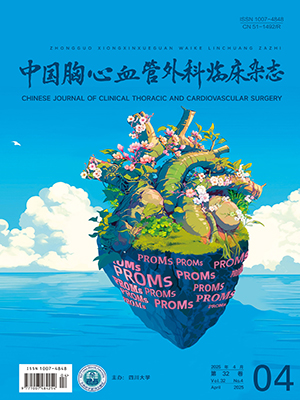| 1. |
郑景浩, 刘玉洁. 新生儿危重先天性心脏病急症治疗进展. 中华临床医师杂志(电子版), 2013, 7(13):5719-5720.
|
| 2. |
杨盛春, 陈欣欣, 崔虎军, 等. 24例低体重危重先天性心脏病患儿的外科治疗. 中华胸心血管外科杂志, 2012, 28(11):680-682.
|
| 3. |
李星, 岑坚正, 陈寄梅, 等. 新生儿危重先天性心脏病的手术治疗. 中华小儿外科杂志, 2013, 34(3):169-171.
|
| 4. |
Samir K, Riberi A, Ghez O, et al. Delayed sternal closure:a life-saving measure in neonatal open heart surgery; could it be predictable? Eur J Cardiothorac Surg, 2002, 21(5):787-793.
|
| 5. |
张惠锋, 贾兵, 陈张根, 等. 3个月内复杂先天性心脏病患儿术后延迟关胸的因素分析. 中华小儿外科杂志, 2008, 29(2):78-81.
|
| 6. |
Mcelhinney DB, Reddy VM, Parry AJ, et al. Management and outcomes of delayed sternal closure after cardiac surgery in neonates and infants. Crit Care Med, 2000, 28(4):1180-1184.
|
| 7. |
潘燕军, 王顺民, 张海, 等. 延迟关胸在先天性心脏病手术后的应用体会. 中华胸心血管外科杂志, 2014, 30(8):449-451.
|
| 8. |
张玉龙, 李仲智, 李晓, 等. 延迟关胸在小儿心脏外科应用的经验. 中国体外循环杂志, 2007, 5(1):20-22.
|
| 9. |
Jenkins KJ, Gauvreau K, Newburger JW, et al.Consensus-based method for risk adjustment for surgery for congenital heart disease. J Thorac Cardiovasc Surg, 2002, 123(1):110-118.
|
| 10. |
Padley JR, Cole AD, Pye VE, et al. Five-year analysis of operative mortality and neonatal outcomes in congenital heart diseases. Heart Lung Circ, 2011, 20(7):460-467.
|
| 11. |
Cheng HH, Almodovar MC, Laussen PC, et al. Outcomes and risk factors for mortality in premature neonates with critical congenital heart disease.Pediatr Cardiol, 2011, 32(8):1139-1146.
|
| 12. |
Riahi M, Tomatis LA, Schlosser RJ, et al. Cardiac compression due to closure of the median sternotomy in open-heart surgery. Chest, 1975, 67(1):113-114.
|
| 13. |
Misawa Y. What can be an indicator of delayed sternal closure after cardiac surgery? Eur J Cardiothorac Surg, 2002, 22(3):493-494.
|
| 14. |
Boeken, Assmann U, Mehdiani A, et al. Open chest management after cardiac operations:outcome and timing of delayed sternal closure. Eur J Cardiothorac Surg, 2011, 40(5):1146-1150.
|
| 15. |
Misawa Y. Indication for delayed sternal closure. J Thorac Cardiovasc Surg,1997, 114(5):874.
|
| 16. |
Furnary AP, Magovern JA, Simpson KA, et al. Prolonged open sternotomy and delayed sternal closure after cardiac operations. Ann Thorac Surg, 1992, 54(2):233-239.
|
| 17. |
Allpress AL, Rosenthal GL, Goodrich KM, et al. Risk factors for surgical site infections after pediatric cardiovascular surgery. Pediatr Infect Dis J, 2004, 23(3):231-234.
|
| 18. |
Horvath R, Shore S, Schultz SE, et al. Cerebral and somatic oxygen saturation decrease after delayed sternal closure in children after cardiac surgery. J Thorac Cardiovasc Surg, 2010, 139(4):894-900.
|
| 19. |
Woodward CS, Son M, Calhoon J, et al. Sternal wound infections in pediatric congenital cardiac surgery:a survey of incidence and preventative practice. Ann Thorac Surg, 2011, 91(3):799-804.
|
| 20. |
Mehta PA, Cunningham CK, Colella CB, et al. Risk factors for sternal wound and other infections in pediatric cardiac surgery patients. Pediatr Infect Dis J, 2000, 19(10):1000-1004.
|




